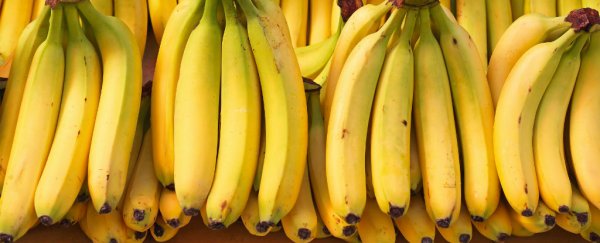When it comes to the world's favourite fruit, history is repeating itself, with the most popular banana at serious risk from the Panama disease - a fungicide-resistant pathogen that's crossed continents and breached quarantine efforts to spread across South Asia, Africa, the Middle East, and Australia.
According to a new study by researchers in the Netherlands, the across-ocean leap to South America is now inevitable, and that's a huge problem. This is where 82 percent of the world's Cavandish bananas - by far the world's most popular banana variety - are grown, with Ecuador alone supplying over a third of the billion-dollar global export market.
The threat is Panama disease, the exact same soil-borne fungus that drove the original favourite banana, the Gros Michel, to near-extinction in the 1960s. Its effects were first discovered way back in 1876, when a wilting disease was reported in Australian banana crops. By 1890, the same disease appeared in Gros Michel crops in Costa Rica and Panama, and 20 years later, it was finally attributed to the fungus Fusarium oxysporum f.sp. cubense (Foc).
This fungus is incredibly efficient at infecting banana crops, and when it does, it's devastating. Transmitted through both soil and water, F. oxysporum can lay dormant in the soil for up to 30 years, and it's virtually impossible for growers to know their crops have it without rigorous testing (which doesn't exist). Once it latches onto a suitable host, it finds its way to the root system and travels up to the xylem vessels - a plant's main water transporters.
From here, the fungus messes with the plant's vascular system, causing it to wilt rapidly and turn a horrible yellow-brown colour due to a lack of water. The plant will then die very quickly from dehydration.
Before farmers even knew what hit them, Panama disease had spread through most of the world's Gros Michel banana crops, wiping them out everywhere but in certain parts of Thailand, where small plantations are keeping the variety alive.
"Fortunately, there was a remedy: Cavendish bananas - maintained as interesting specimens in botanical gardens in the United Kingdom and in the United Fruit Company collection in Honduras - were identified as resistant substitutes for Gros Michel," researchers from Wageningen University and Research Centre report in PLOS Pathogens. "A new clone was 'born' that, along with the new tissue culture techniques, helped save and globalise banana production."
But now Panama disease is back, in the form of a new strain called VCG01213, or Tropical Race 4 (TR4). The team, led by plant researcher Nadia Ordonez, has confirmed that TR4 is a single clone of the original Panama disease, and it alone is what's causing the current worldwide die-off of Cavendishes.
"We know that the origin of [Tropical Race 4] is in Indonesia and that it spread from there, most likely first into Taiwan and then into China and the rest of Southeast Asia," one of the team, Gert Kema, told Gywnn Guilford at Quartz. He says they've identified the deadly fungus in Pakistan, Lebanon, Jordan, Oman, and Mozambique, and Australia's northeast Queensland.
To any banana farmers out there, this isn't exactly news, but the study has finally confirmed suspicions that have been floating around since the 1980s - the Cavendish might have been immune to the Panama disease strain that killed off the Gros Michel, but it's super susceptible to TR4. And the fact that Cavendish bananas are seedless clones of each other means there's zero genetic diversity in the entire global population to allow for a resistant population to develop.
So what now? As Guilford reports for Quartz, our bananas aren't going to disappear overnight, but they will eventually decline in a really big way if things don't change fast. "It takes time for Tropical Race 4 to spread. But once it takes root, the decline is inevitable," she says. "Taiwan, for instance, now exports around 2 percent of what it did in the late 1960s, when Tropical Race 4 was first discovered there."
The fix isn't an easy one, with Ordonez and her team recommending "drastic strategy changes". The most important thing the international community can do is eliminate infected crops, and for this to be realistic, scientists need to invent a new diagnostic test that can very quickly detect the disease in plantations and at quarantine borders. We also need to start seriously considering the development of a Cavenish replacement.
"Developing new banana cultivars, however, requires major investments in research and development and the recognition of the banana as a global staple and cash crop (rather than an orphan crop) that supports the livelihoods of millions of small-holder farmers," the researchers conclude.
Let's just hope we end up doing something before it's too late.
